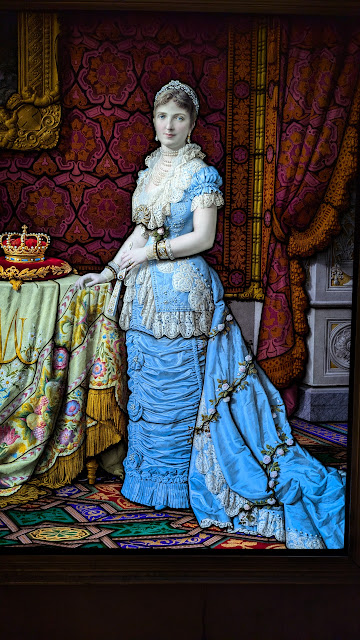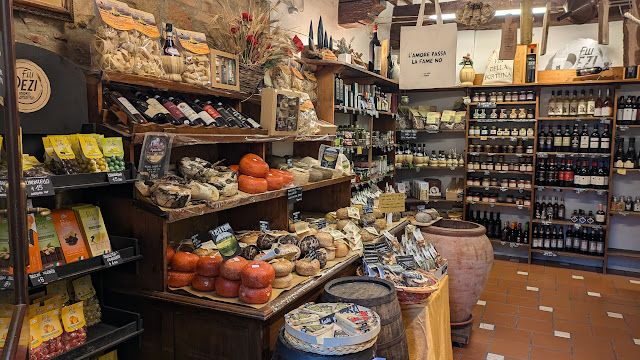Tuscany and Umbria, Part II: Assisi, Montepulciano, Pitigliano, Sovana, Pienza, Perugia, Spoleto, Spello
Pienza is a "planned town" because in the 1400's, locally born Pope Pius II (1405-64, educated writer and diplomat from a prestigious Sienese family) decided to remodel his town called Corsigliano, built on a flat plateau, surrounded by rolling hills, into a city fit for a pope. He renamed it Pienza after Pope Pius. It was designed by architect Rossellino, and built it in the fashionable Renaissance style. It certainly is charming. The best are the sunsets!

Linda's ceramic shop was an ancient Etruscan tomb, and the oldest well is within the cave (below).
In Montepulciano, known for its thermal baths, in the Val d'Orcia region we descended to a wine cave and had a light lunch
The views and the Palazzo Comunale were beautiful!
September 30 we spent the morning at the Etruscan Museum in Chianciamo staffed and funded by local volunteers who have recently excavated a site, the Acropolis di Tolle, a few kilometers away. The Etruscans lived in 9-2 century BC in Tuscany and Umbria between the Arno and Tiber Rivers. They were merchants, not warriors and treated women as equals with men. They used cremation (remains contained in canopies jars), were meat eaters, and have a unique language, written from right to left, which is still not well deciphered. It is believed they came from an area around Albania/Turkey. Rome finally assimilated them in 2BC.
We enjoyed modeling a piece in gray clay using Etruscan symbols
Tombs are filled with pots, jewelry and other very sophisticated possessions of the deceased person. They practiced human sacrifice
Lodo is demonstrating a couch where men and women reclined and played a game like our "spin the bottle."
The optional tour on October 1 to Pitigliano and Sovano was great. We crossed the Marema, the wildest area of Tuscany, famous for its historical villages built on tufa (lava) hills
The old aqueduct of Pitigliano, then down a narrow street to the Jewish ghetto, on the cliff side. Ghetto comes from the Venetian word ghettare= throw away. Jews began settling her in the 1622, seeking refuge after being expelled from the Papal State in Rome during the counter-revolution persecutions. About 1/4 population were Jewish. During WWII all the town's Jews escaped Nazi persecution with the aid of their mostly Catholic neighbors, with whom they had been integrated for centuries.

There was a bakery, winery, weaving and cloth dying shop
Above are bake ovens. There was also a ritual bath (Miqve)
The synagogue built in 1598, collapsed in a landslide in 1960's, and rebuilt in 1995. It is now a museum, as only one family is left.
Across the gorge, built into the tufa rock are some amazing Etruscan tombs. The many miles of "road" was all built by hand, and restored later. It was also used as an escape route, as it is invisible from the air.
Fernanda was a very knowledgeable guide through the underground Sovana Necropolis tombs, all with sloping entrances. There were 12 Etruscan cities which were not united, so unable to defend themselves. The poor man cremated, the rich, buried in an elaborate sacophagus. During the 1800's tomb robbers looted so there are not artifacts left.
Hildebrand (discoverer) tomb.
Figures reclined and were guarded by lion and other sculptures. Romans copied the Etruscans, who copied the ancient Greeks.
October 2 we departed Pienza for Perugia and Spoleto in Umbria, "green heart of Italy" and the only landlocked region. We visited a family-owned Turan chocolate factory in Perugia, where we each made a yummy dark chocolate bar under the direction of Julia.
Margarita di Savoy (first Italian queen) is so rich! The house is fun too
I have had these framed photos in my home for years and loved seeing the originals on the St. Francis basilica again!
Spoleto is a beautiful walled town, surrounded by the Apennine Mountains, with a restored amphitheater and more.
Ponte delle Torri, a 14th century bridge, actually an aqueduct built on ancient Roman foundations, running over a gorge. I walked around "La Rocca" with great panoramas. We had only 1-2 days of rain in all.
The Duomo di Spoleto is 11th century, made from old Roman stones, rebuilt in 1644, with gorgeous Fra Lippi frescoes. The 8 rose windows symbolize infinity.
I loved the Umbrian Folk Music optional tour in Spello. Unfortunately it was pouring rain, but we enjoyed all the pots of flowers everywhere and the tiny winding streets of this old walled town in east central Umbria. Our bus driver let me practice my Italian and does not like tomatoes. My cheese crepes, bruschetta, and mil foglia were delicious
Gianlucco on accordion, Stefano on guitar, Claudio singer and group leader played wonderful folk music, some traditional, some their own, and had a great story and props for each one. Donkey Home Theater in back of a store. I bought 2 CDs and am enjoying listening to them.
Jean, Jean, Sandy, Fran, Diane, and Mary, Gary, Kevin (front),Miriam
October 4 was a fun day with Bruno, a truffle hunter since 1969, and his dog Enea in a birch forest in an Umbrian mountain village in the Apennines. The dog does the digging. Medium-sized are usually best

For lunch we ate truffle antipasti, and eggs with truffles. Fortunately the dessert wasn't truffles but a very typical tarte.
Nearby we saw the oldest (1700 yrs) olive tree in Italy where Bishop of Trevi, San Emiliano was beheaded on orders from Diocletian for performing marriages between Roman soldiers and Christian women.
Monument to the fighters for the Italian Republic. There were many who died, even children. Their busts line the street from which we had such a beautiful view of the city and Vatican, Saint Peter's
In 1843, Joseph Toronto (born Giuseppe Taranto) became the first known Italian convert to The Church of Jesus Christ of Latter-day Saints when he was baptized in Boston, Massachusetts. In 1849, Taronto was among the first missionaries to his homeland when he accompanied Church Apostle Lorenzo Snow and others in opening a Church mission. This first mission was short-lived; it was closed in 1867, but a handful of converts remained. This is a modern painting of what these early leaders saw as they came over the mountains into Italy, Mount Brigham, and the below painting portrays how they may have imagined a modern-day temple in Italy.
For our farewell dinner at a local restaurant, we enjoyed guitar, saxophone and vocal music, and Margaret Norman and Judy and Kevin Landon received gifts for their many (20 each?) trips with OAT!
 We are especially grateful to our wonderful leader Lodovico, whose American-born partner Celina and 3 month old baby Chloe came to meet our group in Rome, their home
We are especially grateful to our wonderful leader Lodovico, whose American-born partner Celina and 3 month old baby Chloe came to meet our group in Rome, their home
A few other photos that typify Italy, mostly involving food! Grated truffles; delicious pizza, bikes, chocolate and lots of cheese and gelato!
Teenagers are alike around the world. Tiny mail cars!
and very rowdy drunk tourists; these Estonians celebrating a wedding




















































































































No comments:
Post a Comment